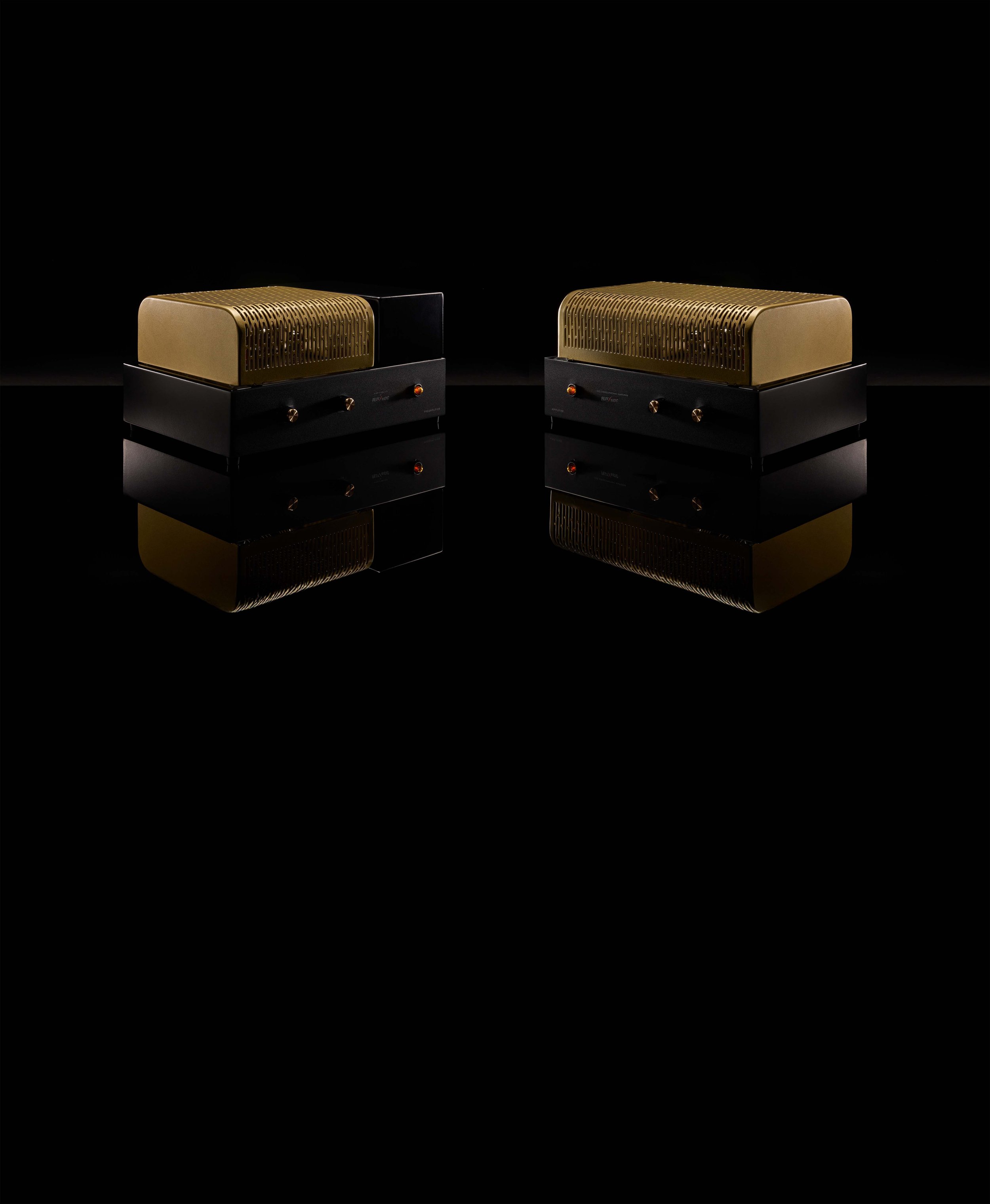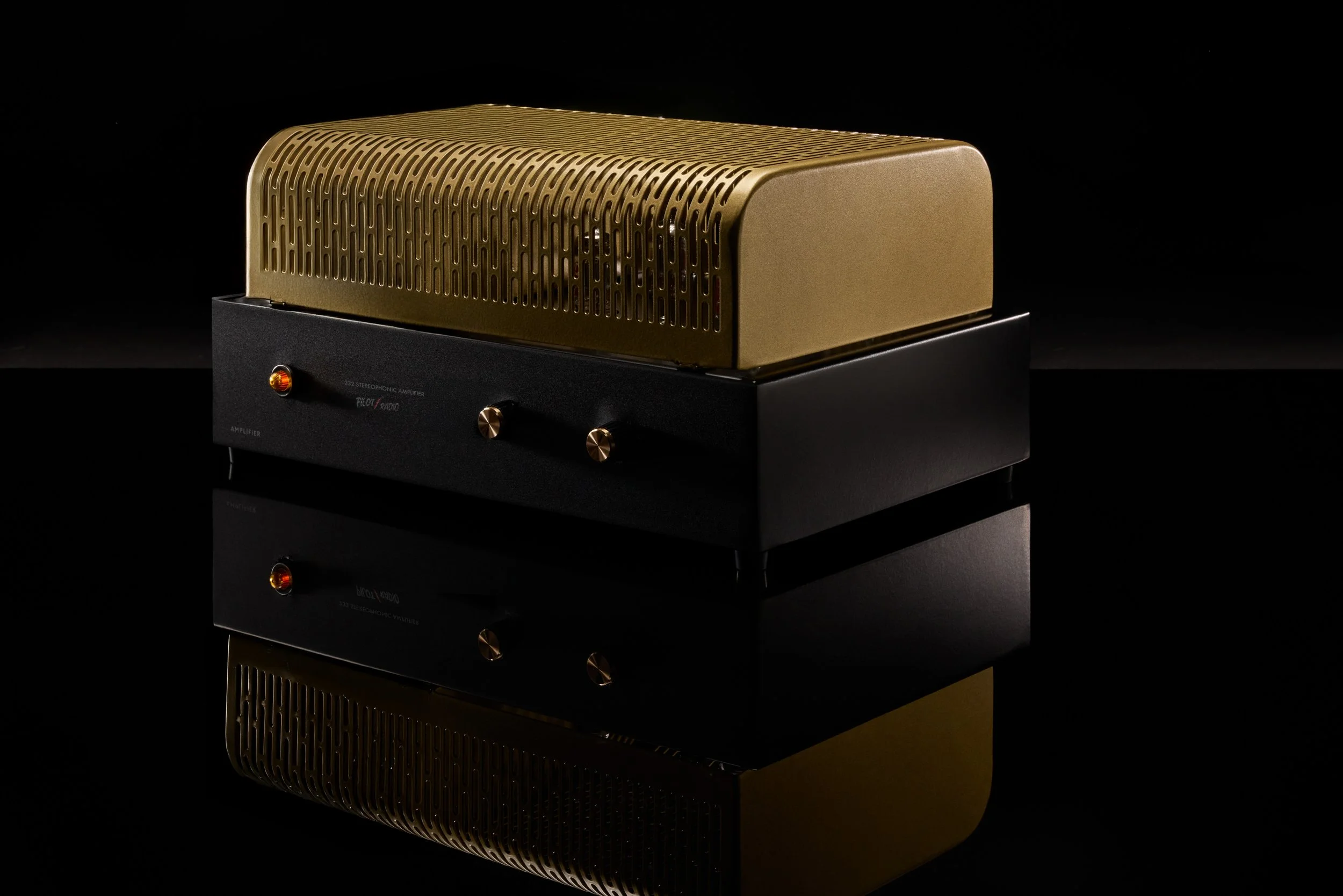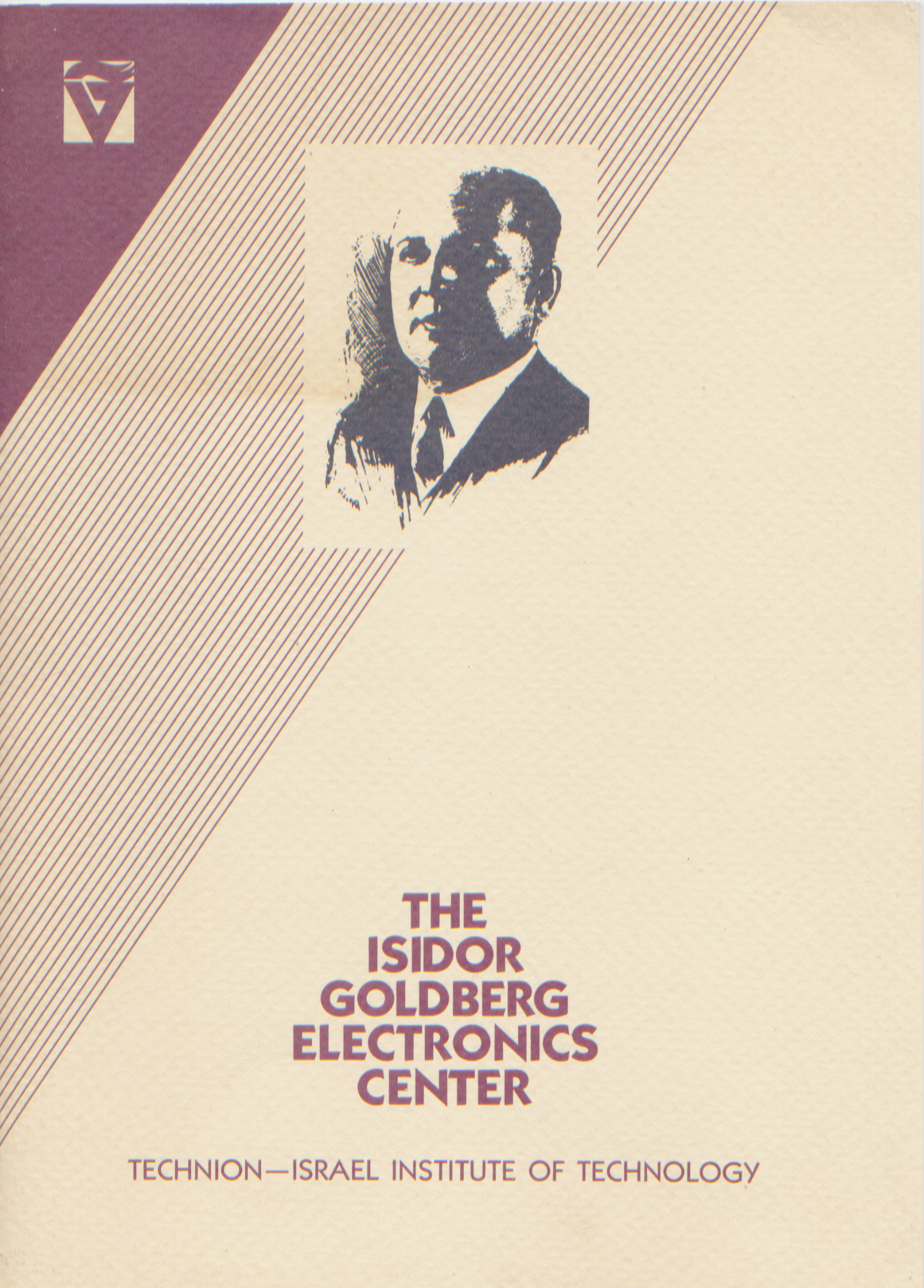
Rediscover the art of listening
Pilot Radio established in 1919 and re-launched in 2025 for the manufacture of high fidelity products.Built to honor music—untouched, uncolored, and alive.
PREAMPLIFIER: the sound philosophy
The key to the Pilot Radio sound lies in our meticulous engineering choices:
-
No negative feedback, no unnecessary processing—just pure, organic sound.
-
Every signal moves naturally, uninterrupted, and unaltered. Every design choice is intentional, ensuring that music reaches your ears exactly as it was recorded.
-
The gold standard in preserving frequency integrity.
-
Fewer components, cleaner signal paths, and a seamless listening experience.
why passive riaa?
Most modern phono stages use active RIAA equalization, relying on negative feedback circuits that can distort harmonic structure. Passive RIAA filtering, as implemented in the Pilot Radio Phono / Line Amplifier, eliminates these artificial adjustments.
-
Hand-selected capacitors & resistors ensure absolute accuracy.
-
No negative feedback means no artificial compression of musical detail.
-
A dedicated, shielded power supply minimizes noise and interference, keeping the sound pure. The result? Explosive peaks, intricate details, and an organic vibrancy that digital reproduction simply cannot match.
Engineering That Listens to the Music
-
Unlike common PCB layouts, the Pilot Radio amplifier follows a straight-line signal path, avoiding radical angles or unnecessary crossings. This keeps the audio signal as pure as possible.
-
OIP Capacitors – Oil-in-Paper (OIP) capacitors eliminate frequency loss and distortion, ensuring that every nuance in your music is faithfully preserved.
-
A careful blend of point-to-point wiring, turret connections, and a single-sided circuit board ensures sonic clarity while maintaining structural integrity.
Less is More: Integrated Phono & Line Stage
Why add unnecessary boxes, cables, and complexity when one amplifier can do it all? The Pilot Radio Phono Amplifier functions as both a phono stage and a full line amplifier, removing extra interconnects that degrade signal purity.
-
Selectable Phono MM & MC inputs for ultimate flexibility.
-
Minimalist design with no unnecessary bass/treble controls—because music should be heard as the original engineer intended.
-
A seamless signal path means better dynamics, greater detail, and an immersive listening experience.
Technical Specifications
-
2 x 12AX7 / ECC83
2 x 12AU7 / ECC82 -
Line Stage: 17.5 dB (50K input) / 14 dB (10K load)
Phono MM: 26dB + Line Stage (~44dB max)
Phono MC: Selectable 46dB / 52dB + Line Stage (~64dB / ~70dB max) -
Passive: ±1 dB / -1.5 dB from 20Hz - 20KHz
Phono Rumble Filter: 7Hz, 3dB/octave -
Line 1, Line 2
Phono MM, Phono MC (switch selectable at rear inputs) -
120V / 240V (specified at the time of purchase)
A True Vinyl Experience
Every note, every breath, and every dynamic shift in the music comes alive with the Pilot Radio Phono / Line Amplifier
This preamplifier is built to honor music—untouched, uncolored, and alive. If you demand a preamplifier that honors the integrity of your vinyl collection, this is your moment. Inspired by the pioneering designs of Coffman Labs' G1-A and G1-B.
✔ Experience music as it was meant to be heard.
✔ Reignite your passion for dedicated listening.
✔ Own a piece of high-fidelity history.
232 stereophonic power amp
Technical Specifications
-
2 XLR Balanced inputs to direct differential amp drive
2 RCA Line inputs
Switchable XLR / RCA outpu -
-
Custom transformers made in USA
Vintage Oil–in–Paper capacitors
Point–to–point hand wiring
Pure Class A amplification
10W per channel using EL84 tubes
-
4Ω or 8Ω
-
120V
The Pilot way: produce the finest instruments possible, then price it accordingly. Our policy is not cost for costs sake, but for performance sake.it by the pioneering designs of Coffman Labs' G1-A and G1-B.
COMING SOON
“The standard in excellence in home music systems”
Our power amp, called the 232, is a re-design of the highly regarded original 1959 era, all tube amp design, the “Curtain of Sound”.
The 2026 new product is designed and built in Portland and Dallas.
✔ Experience music as it was meant to be heard.
✔ Reignite your passion for dedicated listening.
✔ Own a piece of high-fidelity history.
Warmth. Depth. Soul.
The Power of Tubes, Revived for Modern Ears
Not everything new is better. Hand-selected by PSVANE for Pilot Radio, our premium vacuum tubes restore the rich, natural warmth that digital sound forgot—delivering an organic, immersive listening experience like no other.
Vintage Glow, High-Fidelity Performance
From classic triodes to meticulously tuned circuits, Pilot Radio’s tube technology blends nostalgic craftsmanship with precision engineering—so every note resonates with depth and detail, just as the artist intended.
HERITAGE
The Roots of Better Listening
1919
The Birth of High-Fidelity Innovation
In 1919, Isidor Goldberg, a visionary engineer, airplane pilot and inventor, founded Pilot Electric Manufacturing Company in Brooklyn, New York. Holding multiple patents, his passion for sound and relentless pursuit of innovation laid the groundwork for what would become a defining name in high fidelity audio.
A graduate of the Hebrew Technical Institute, Goldberg was a test pilot for Curtis Airplanes from 1910 to 1912 and began inventing products in 1915. His expertise in electrical engineering and radio technology positioned him at the forefront of the audio revolution.
Under his leadership, Pilot Radio became one of the first companies to develop high-quality radio receivers and amplification systems, setting new standards for audio performance.
As radio waves began shaping global communication, Goldberg’s pioneering spirit drove Pilot Radio’s early breakthroughs in shortwave and FM radio, amplifiers, television, and high-fidelity sound reproduction. His dedication to craftsmanship and sonic purity would influence generations of audiophiles, bringing music and voices to life with unprecedented clarity.
1928
Pushing the Boundaries of Broadcast Technology
As radio waves revolutionized communication, Pilot Radio ventured into the future of broadcast technology. In 1928, the company conducted one of the earliest television tests, transmitting an experimental broadcast with 36 lines of resolution and 15 frames per second. Pictured on the left is Goldberg with chief engineer John Geloso.
This pioneering test marked Pilot Radio’s first steps toward television innovation, demonstrating the company’s commitment to pushing the limits of sound and vision.
This test marked Pilot’s first step into television, showing its drive to push the limits of sound and vision and shape the future of technology.
1929
The Golden Age of Radio and Cinema
As radio becomes the heart of homes worldwide, Pilot Radio pushes boundaries in sound reproduction. The introduction of high-fidelity amplification ensures that every broadcast—jazz, news, or symphony—is delivered with warmth and depth, shaping how people connect through sound.
Pilot introduces the Super Wasp radio, the first completely AC-operated short-wave receiver in the market.
In 1929, Pilot also enters the cinema industry with a push-pull tube amp designed for motion picture preproduction following the advent of talking motion pictures.
1933
A New Era of Radio Design
In 1933, Isidor Goldberg and Pilot Radio and Tube Corporation took a bold step forward in radio innovation with the patent for a new radio cabinet design (U.S. Patent Des. 89,555). This wasn’t just about function—it was about blending high-fidelity sound with striking aesthetics, making radios an elegant centerpiece in homes across America.
With this patent, Pilot Radio helped shape the future of radio receivers, proving that superior sound could be matched with beautiful craftsmanship. The 1930s marked the rise of home entertainment, and Pilot Radio was at the forefront, ensuring that both design and performance remained timeless.
1937
Bringing Television to the Public
By 1937, Pilot Radio had moved beyond experimentation and into commercial television production, becoming one of the first companies to offer television sets to the public. At a time when TV technology was still in its infancy, Pilot Radio brought the future into homes, making visual broadcasting a reality for early adopters. This milestone reinforced Pilot Radio’s reputation as a pioneer in both sound and vision, bridging the gap between innovation and accessibility. As radio had once transformed the way people connected with the world, television was now poised to do the same—and Pilot Radio was at the forefront of this revolution.
This same year, Pilot offered the first self–contained battery portable radios.
1940s
A New Standard in Audio Fidelity
The vacuum tube era reaches new heights. With advancements in amplification, Pilot Radio defines the signature warmth and resonance that audiophiles will come to revere. These innovations set the standard for dedicated listening, making music more lifelike than ever before.
1941
The FM Radio Revolution
With the introduction of FM radio, Pilot Radio helps redefine broadcast sound quality. This era brings clearer, richer, and more dynamic radio experiences, transforming how people listen to music and news.
1947
The T500: A Radio for a New Era
In 1947, Pilot Radio introduced the T500, a beautifully crafted tabletop radio that embodied the golden age of broadcast sound. With its sleek design and high-fidelity performance, the T500 became a household staple, delivering rich, detailed audio that brought music, news, and entertainment to life.
As the post-war world embraced a new wave of technological advancements, Pilot Radio continued to push the boundaries of radio engineering, refining sound quality while maintaining the timeless warmth that defined its legacy. The T500 was more than just a radio—it was an invitation to experience audio the way it was meant to be heard.
1950s
The Hi-Fi Boom & Domestic Audio Expansion
With the rise of hi-fi culture, Pilot Radio introduces premium home audio systems. These designs merge cutting-edge technology with sleek aesthetics, appealing to a new generation of music lovers.
In 1950, The Institute of Radio Engineers and the American Institute of Electrical Engineers at New York University commemorated the 22nd anniversary of when station WRNY inaugurated regular daily television broadcast service. The event was called “How a Television Picture Looked in 1928”.
In 1952, Pilot changed course to produce Hi-Fi Equipment exclusively.
In 1954, Consumer Reports rated the Pilot AA-903 Mono Block amp as one of the best buy amplifiers of the year.
In 1959, Pilot introduced a new concept in stereophonic home music reproduction - ‘The Curtain of Sound”.
Pilot engages the services of Hi-Fi audio engineers Sid Smith and Dick Sequerra who later went on to work for Marantz.
1960s
Stereo Sound Becomes the Standard
Pilot Radio helps transition the industry from mono to stereo, refining amplifier and speaker systems to deliver a more immersive audio experience. This shift solidifies the importance of high-fidelity stereo systems in homes worldwide.
In November 1961, the world of high-fidelity audio lost a true pioneer. Isidor Goldberg, the visionary founder of Pilot Radio, passed away, leaving behind a legacy of innovation that shaped the future of sound and broadcasting. From the early days of radio and shortwave transmission to the introduction of commercial television, Goldberg’s relentless pursuit of audio perfection and technological advancement positioned Pilot Radio as a leader in high-fidelity sound. His contributions not only revolutionized home entertainment but also laid the foundation for generations of audiophiles to experience music with unmatched clarity and depth. Though Goldberg’s era came to an end, his vision continues to inspire, proving that great sound is timeless.
Pilot Radio is sold in 1962, and continues as a hi-fi brand for another 10 years before parent company brand consolidation in the 70’s.
Dedicated in 1966, the Goldberg Electronics Center at Technion - Israel Institute of Technology, continued his creative spirit and helped guide the next generation of electronic breakthroughs.
1960’s
The End of an Era, The Legacy Lives On
2025
The Revival of Pilot Radio
Pilot Radio is relaunched by Isidor Goldberg's great-grandson, Barak Isidor Epstein, with historical context and consulting from Goldberg's grandson, Robert Epstein. The new family team engages the services and expertise of modern tube physicist and engineer, Damon Coffman to start building products for the hi-fi market. A PreAmplifier is launched in March 2025 in Dallas Texas.
























